The “Parisienne” is a captivating fragment of a fresco that showcases the artistic brilliance of the Minoan civilization. Discovered in Knossos, Crete, this remarkable artifact dates back to the Final Palatial period (circa 1400–1350 BC) and continues to fascinate historians and art enthusiasts alike. Let’s explore its history, significance, and what makes it a must-see artifact at the Heraklion Archaeological Museum.
Follow archeology.dulichvn.net to discover many hidden mysteries that have yet to be discovered.
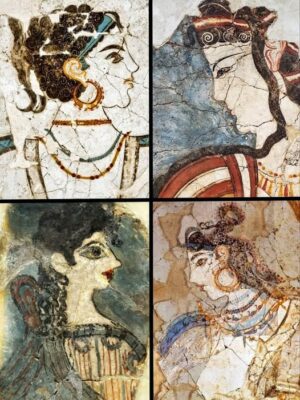
1. Unveiling the “Parisienne”: A Glimpse Into Minoan Art
1.1. Historical Background: The Late Minoan Flourishing Era
The “Parisienne” fresco hails from the Late Minoan period, a golden age of artistic and architectural innovation in ancient Crete. This era, spanning approximately 1400–1350 BC, marked a pinnacle of cultural refinement as the Minoans created vibrant, intricate works that adorned the walls of their magnificent palaces.
These frescoes served multiple purposes, from celebrating everyday life and religious ceremonies to depicting mythical and symbolic themes central to Minoan spirituality and identity. The frescoes were not merely decorative; they were a testament to the Minoans’ advanced techniques in natural pigment use, composition, and perspective, reflecting a deep connection between art, society, and their natural environment.
1.2. Discovery at the Palace of Knossos: A Window to the Past
The “Parisienne” fresco was discovered amidst the ruins of the Palace of Knossos, an architectural marvel and the largest Minoan palace on Crete. As the heart of Minoan administrative, ceremonial, and cultural activities, the palace housed elaborate rooms, sanctuaries, and vibrant wall paintings.
Unearthed during the famous excavations led by Sir Arthur Evans in the early 20th century, this fresco fragment was found in a context that suggested its role as a decorative element in a space of ceremonial or religious significance. The precise placement and detail of the artwork underscore its importance, offering modern viewers a glimpse into the aesthetic sophistication and social structure of the Minoan world.
1.3. The Enigmatic Name “Parisienne”
The “Parisienne” fresco earned its evocative name from the graceful and refined depiction of a woman whose appearance evoked comparisons to the chic elegance of a Parisian lady. This poetic title, given by early archaeologists and historians, highlights the timeless allure of the subject’s poised demeanor, expressive features, and striking beauty.
While the name reflects a modern interpretation, it underscores a universal admiration for beauty that transcends cultural and temporal boundaries. The figure, with her carefully detailed attire and captivating expression, serves as both an artistic marvel and a symbol of the Minoans’ appreciation for individuality and sophistication.
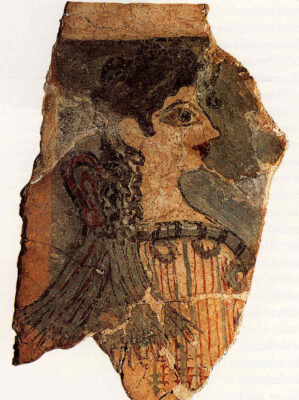
2. Artistic Features of the “Parisienne” Fresco
2.1. Mastery of Color and Detail: A Testament to Minoan Artistry
The “Parisienne” fresco is a striking example of the Minoans’ unparalleled skill in the use of vibrant colors and meticulous detail. The subject is brought to life through a harmonious palette: alabaster skin that glows with vitality, dark, flowing hair rendered in intricate strands, and striking red lips that convey a sense of sophistication.
These colors, derived from natural pigments like ochres, cinnabar, and charcoal, highlight the Minoan artisans’ expertise in creating durable, vivid hues that have withstood the test of time. The lifelike quality of the fresco, achieved through the careful blending of shades and delicate brushwork, underscores the Minoans’ dedication to realism and their deep appreciation for human beauty.
2.2. A Priestess or Noblewoman: The Identity of the “Parisienne”
The subject of the “Parisienne” fresco has long intrigued scholars, who suggest she represents a figure of high social or religious importance. Her ceremonial attire, featuring a richly detailed bodice and ornamented accessories, suggests her role as either a noblewoman or a priestess within Minoan society.
The elaborate hairstyle, adorned with curls and possibly jewels, further emphasizes her elevated status. This depiction aligns with the Minoan tradition of highlighting influential female figures in their art, reflecting a culture that placed significant value on women’s roles in both ceremonial and societal contexts. Whether a spiritual leader or a member of the elite, the “Parisienne” embodies the grace and authority of her position.
2.3. Symbolism and Spirituality: The Minoan Artistic Vision
Minoan frescoes were rarely purely decorative; they often carried profound symbolic meanings. The “Parisienne,” with her poised demeanor and richly adorned appearance, is a reflection of the Minoans’ reverence for beauty, spirituality, and societal roles.
Her depiction may symbolize the connection between the divine and the earthly, representing the bridge between mortals and gods in Minoan belief systems. Furthermore, the fresco’s intricate details emphasize the Minoans’ cultural values, such as the celebration of femininity, the importance of ritual, and their deep connection to the natural and spiritual worlds. In this way, the “Parisienne” transcends being a mere portrait, becoming a timeless icon of Minoan culture and ideology.
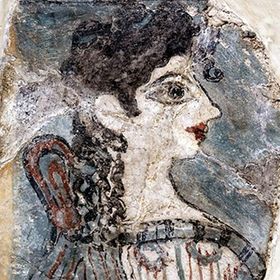
See more: Michelangelo’s Secret Drawing Room: A Hidden Renaissance Treasure in Florence
3. The Legacy of the “Parisienne” Fresco
3.1. Preservation and Restoration: Reviving an Ancient Masterpiece
Following its discovery at the Palace of Knossos, the “Parisienne” fresco underwent a painstaking process of restoration to safeguard its intricate details and vivid colors. Archaeologists and conservators carefully pieced together the fragmented remains, using modern techniques to fill in missing sections while maintaining the integrity of the original artwork.
The restoration process aimed to strike a delicate balance between authenticity and aesthetic continuity, allowing the fresco to retain its historical essence while presenting a coherent image. The result is a breathtaking blend of original fragments and carefully reconstructed elements, offering a glimpse into the grandeur of Minoan artistry as it might have appeared over three millennia ago.
3.2. Display at the Heraklion Archaeological Museum: A Window to the Minoan World
Today, the “Parisienne” fresco is proudly displayed at the Heraklion Archaeological Museum, one of Greece’s most prestigious institutions dedicated to Minoan culture. Positioned as a centerpiece among other treasures from the Palace of Knossos, the fresco captivates visitors with its lifelike detail and timeless beauty.
The museum’s curated exhibits provide valuable context for understanding the role of art in Minoan society, highlighting themes of ritual, power, and daily life. For many, the “Parisienne” serves as a vivid connection to the sophistication and cultural achievements of an ancient civilization, making it a must-see attraction for anyone exploring Crete’s rich history.
3.3. Influence on Modern Art and Culture: A Timeless Inspiration
The “Parisienne” fresco continues to resonate far beyond the confines of the archaeological world, inspiring contemporary artists, historians, and cultural enthusiasts. Her poised elegance, intricate detailing, and expressive features have been celebrated as a testament to humanity’s enduring appreciation for beauty and creativity.
This iconic image has found its way into modern art, literature, and even fashion, serving as a bridge between past and present. Moreover, the fresco symbolizes the ingenuity and sophistication of the Minoans, reminding us of the cultural and artistic foundations that continue to shape our understanding of ancient civilizations. As an enduring legacy of Minoan culture, the “Parisienne” invites us to explore the timeless connection between art, history, and human expression.
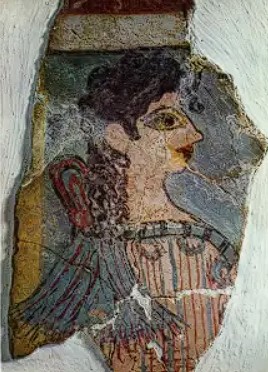
Conclusion
The “Parisienne” fresco is more than just a fragment of ancient art; it is a testament to the sophistication, creativity, and cultural depth of the Minoan civilization. Displayed at the Heraklion Archaeological Museum, it continues to captivate modern audiences, offering a rare glimpse into a bygone era. A visit to witness this masterpiece is a journey into the heart of one of history’s most fascinating cultures.

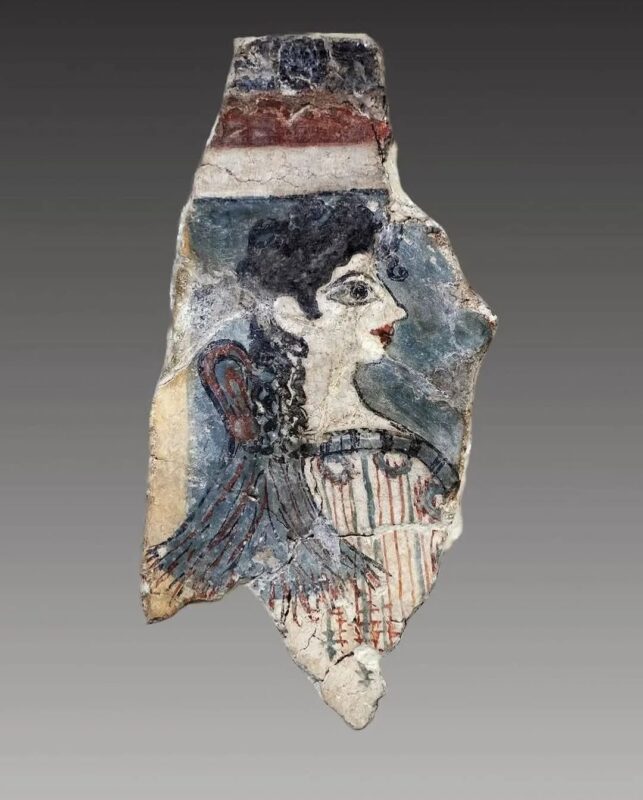
CÁC TIN KHÁC
Mary Walton: The Forgotten Inventor Who Helped Clean Up America’s Cities
Tomb of Queen Nefertari in the Valley of the Queens, Egypt
Discover the Hypostyle Hall of the Temple of Hathor at Dendera
Venus de Losange: Unveiling the Mystery of a 20,000-Year-Old Paleolithic Icon